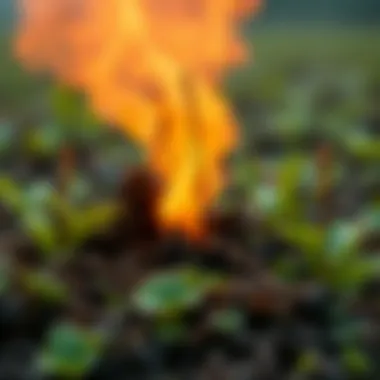Comprehensive Overview of Peat Management Strategies


Intro
In a world where environmental sustainability is fast becoming a priority, understanding peat management is crucial. Peatlands, often dubbed the forgotten ecosystems, play a significant role in carbon storage, biodiversity, and water regulation. Despite their ecological importance, peatlands are under threat due to extraction activities and land-use changes. This article aims to provide a detailed look into the various strategies that can be employed to manage peat resources responsibly, balancing ecological integrity with human needs.
Research Overview
Summary of Key Findings
Recent studies reveal that peatlands account for about 30% of the world's soil carbon, despite covering only 3% of the Earth's land surface. This highlights their critical role in combating climate change. However, peat extraction not only releases stored carbon but also disrupts local ecosystems. An interesting observation from a study conducted in the UK pointed out that rewetting drained peatlands can significantly improve biodiversity and carbon storage.
Background and Context
Peat management strategies have evolved over the years, adapting to the challenges presented by climate change, developments in technology, and shifts in public policy. The importance of these strategies lies not only in preserving a key ecological resource but also in mitigating the negative impacts of human activities. Traditional practices of peat extraction have raised eyebrows due to their long-lasting consequences on the environment. The European Union has implemented several directives focusing on habitat conservation that directly influence how peatlands should be managed.
Methodology
Experimental Design
To understand the effectiveness of various peat management techniques, a comparative analysis was conducted. This involved contrasting regions with traditional peat extraction practices against those employing sustainable management tactics, such as rewetting, afforestation, and peatland restoration. The analysis aimed at gauging differences in biodiversity, carbon levels, and environmental impacts.
Data Collection Techniques
Data was collected through multiple methodologies:
- Field Surveys: These surveys helped gather direct observations of flora and fauna in the respective peatland areas.
- Remote Sensing: Datasets were analyzed to assess land cover changes over time.
- Interviews: Engaging with local communities provided insights into socio-economic impacts and perceptions of peat management.
"Sustainable management of peatlands is not just about conservation; it's about fostering a future where humans and nature coexist harmoniously."
Through this rigorous approach, the findings laid the groundwork for actionable strategies and guidelines that can enhance peatland conservation efforts, ensuring they continue to provide ecosystem services for generations to come.
Prologue to Peat Management
Peatlands, often underrated, play a vital role in our ecology. It's surprising how many people aren't aware of the importance of peat management. Well-managed peatlands can be true powerhouses when it comes to carbon storage, biodiversity support, and water regulation. This section will illuminate why understanding peat management is not just for scientists or policymakers, but for anyone who cares about the environment.
The benefits of proper peat management are manifold. It emphasizes sustainability, ensuring that peatlands can continue to function effectively in environmental systems. With climate change looming over us, recognizing the significance of peatlands can lead to more informed conservation efforts and policies that positively impact our forests and wetlands.
Definition and Importance of Peatlands
Peatlands are unique ecosystems formed from accumulated plant material, primarily sphagnum moss, which decomposes very slowly due to waterlogged conditions. This low decomposition rate leads to the accumulation of organic material. They cover about 3% of the Earth’s land surface while storing roughly one-third of global soil carbon. That's not just a number; it means they are pivotal in mitigating the effects of climate change.
In terms of biodiversity, peatlands are home to many plants and animals, including some that are rare or endangered. They provide essential habitats that contribute to the overall health of our planet. Moreover, that's not all— they regulate hydrological cycles in their regions, influencing water table levels and quality.
"The interaction between plant growth and decomposition in peatlands creates a unique environment that supports diverse wildlife and acts as a significant carbon sink, making their preservation crucial for global climate stability."
Historical Context of Peatland Use
Looking back, the story of peatlands is rich and complex. Historically, many cultures have utilized peat for various purposes— from fuel to horticulture. In some cases, its cutting led to dramatic changes in landscape and ecology—a double-edged sword, to say the least. For instance, in parts of Europe, peat has been used for heating and cooking since the Stone Age. It was a primary energy source long before fossil fuels took center stage.
However, as industries grew, the focus shifted. In the 20th century, extensive drainage for agriculture and peat extraction for gardening materials and biofuels became commonplace, leading to widespread degradation. Each cut, each drain, might seem small, but collectively, they created a ripple effect that endangered entire ecosystems. It’s a stark reminder of how human activities can have both immediate benefits and long-lasting repercussions on ecological integrity.
To conclude, understanding the historical context sets the stage for comprehending present challenges and future directions in peat management. Recognizing past mistakes is crucial to ensuring that we do better in the future, safeguarding these fragile ecosystems while balancing human needs.
Ecological Significance of Peatlands
Peatlands, often dubbed the lungs of the Earth, encompass a unique set of ecosystems that hold immense ecological significance. They act as pivotal carbon reservoirs, contributing to climate stabilization while harboring rich biodiversity. Understanding their ecological relevance is crucial for effective peatland management strategies aimed at conservation and sustainability.
Carbon Sequestration and Climate Regulation
One of the main ecological benefits of peatlands is their capacity for carbon sequestration. These rich, waterlogged ecosystems can store more than twice the amount of carbon found in all global forests combined. When organic matter accumulates in the form of peat, it effectively locks away carbon dioxide, a major greenhouse gas.
However, when peatlands are drained or disturbed, the stored carbon is released back into the atmosphere, exacerbating climate change. For instance, the International Peatland Society estimates that drained peatlands could be responsible for around five percent of global greenhouse gas emissions. Therefore, it’s essential to prioritize restoration and proper management practices to maintain their role in climate regulation.
Key Points on Carbon Sequestration:
- Stability: Peat retains carbon over millennia, making these ecosystems vital for long-term carbon storage.
- Climate Buffer: By acting as a buffer against extreme weather patterns, they help moderate local climates.
- Economic Value: Preserving peatlands can also have economic benefits, reducing costs associated with climate change impacts such as flooding.
"Peatlands possess the unique ability to mitigate climate change by sequestering carbon, proving that nature can be our best ally in this fight."
Biodiversity and Habitat Preservation
Beyond their carbon-storing capabilities, peatlands boast rich biodiversity. They provide habitat for numerous species, many of which are specially adapted to thrive in these unique environments. Endemic flora and fauna, including rare plant species such as sphagnum mosses and certain species of orchids, flourish in peatlands.


This biodiversity is not just about the existence of species; it contributes to ecosystem resilience. Healthy peatland ecosystems can withstand and recover better from stresses such as climate change and pollution. The loss of biodiversity in peatlands can result in unstable ecosystems, which can lead to further environmental degradation.
Importance of Biodiversity in Peatlands:
- Ecosystem Services: Biodiverse peatlands offer services such as water filtration and flood regulation.
- Genetic Reservoirs: They serve as genetic banks for crops, potentially providing new insights into medicine and agriculture.
- Cultural Significance: Many communities depend on these ecosystems for cultural practices and livelihoods, intertwining social and ecological health.
Water Regulation and Quality Enhancement
Another essential role of peatlands is their function in water regulation. These ecosystems can store large volumes of water, releasing it slowly to the surrounding environment. This slow release helps in maintaining the hydrological balance, reducing the risks of drought and flooding.
Moreover, peatlands play a significant role in enhancing water quality. They naturally filter pollutants, thus safeguarding downstream ecosystems and human water supplies. For instance, riparian peatlands can remove nutrients and sediments from runoff before they reach rivers and lakes. Conversely, disturbed peatlands often lead to increased sedimentation and nutrient loading in nearby water bodies, creating further ecological issues.
Benefits of Water Regulation:
- Flood Mitigation: By holding water, peatlands can reduce peak flood flows and protect adjacent farmlands and settlements.
- Quality Improvement: Wet peatlands improve the clarity and quality of water entering local streams and rivers.
- Biodiversity Support: By maintaining hydrological cycles, they support diverse plant and animal species that rely on stable wet environments.
In summary, the ecological significance of peatlands encompasses a spectrum of interrelated benefits. From climate regulation to serving as biodiversity hotspots and improving water quality, these unique ecosystems are invaluable. Effective peat management strategies must prioritize the preservation and restoration of peatlands to sustain their critical ecological functions.
Challenges in Peat Management
Peat management is not a walk in the park; it’s a complex and nuanced field with its own unique set of challenges. These challenges arise from various environmental, economic, and societal factors that intertwine and often complicate effective management strategies. Understanding these hurdles is crucial for anyone engaged with peatland ecosystems, be it researchers, policymakers, or environmentalists. The significance of addressing these challenges cannot be understated, as the health of peatlands holds critical implications for biodiversity, carbon storage, and climate resilience.
Impact of Climate Change on Peatland Systems
Climate change poses a significant threat to peatland systems, fundamentally altering their hydrology and ecology. With rising temperatures and changing precipitation patterns, these once-stable environments are becoming increasingly vulnerable. For example, peatlands that were previously saturated may experience drier conditions, leading to greater rates of carbon dioxide release into the atmosphere. This not only contributes to the greenhouse effect but also diminishes the peatlands' ability to function as carbon sinks.
- Altered Water Levels: As the climate warms, evaporation increases, causing peatlands to dry out. This alteration can stress local flora and fauna, resulting in shifts in species composition.
- Increased Wildfires: Dry peat areas are like a powder keg during warmer months, with wildfire risks rising dramatically. Not only do these fires impact local ecosystems, but they also release stored carbon into the air, exacerbating climate change.
- Feedback Loops: The interaction between climate change and peatland degradation creates feedback loops, where the effects of climate change lead to further peatland degradation, which in turn accelerates climate change.
Degradation from Industrial Activities
Industrial activities, including agriculture, mining, and infrastructure development, have significantly contributed to peatland degradation over the years. These activities can transform vibrant peatlands into lifeless landscapes, stripping away their ecological functions. The extraction processes often involve draining the peat, leading to a complexity of reactions within the ecosystem.
- Agricultural Expansion: Large-scale agriculture employs extensive drainage, which is detrimental to peat ecosystems. The rapid conversion of peatlands to farmland often leads to irreversible damage.
- Peat Extraction: The commercial harvesting of peat for fuel or horticultural use can lead to significant land degradation. Besides destroying habitats, the extraction process releases large amounts of carbon stored within the peat.
- Infrastructure Development: Projects such as roads or urbanization can cause fragmentation and further degradation of peatland areas, leading to habitat loss and increased vulnerability to invasive species.
Invasive Species Threatening Peatland Integrity
Invasive species represent another hurdle in the complex landscape of peat management. These non-native species can rapidly out-compete indigenous flora, altering the structure and function of peat ecosystems. In a peatland context, the introduction of such species can have far-reaching consequences.
- Disruption of Biodiversity: Invasive plants can alter nutrient cycling and disrupt established food webs, threatening native plant and animal species.
- Altered Ecosystem Function: The presence of non-native species can lead to changes in water retention and soil composition, impacting the peat's ability to sequester carbon.
- Management Costs: Controlling invasive species requires resources, often straining local communities and management efforts, diverting funds and attention away from more pressing conservation needs.
"Effective peat management must take into account not only the existing pressures but also the dynamic interactions that shape peatland ecosystems over time."
In summary, the challenges facing peat management are multifaceted and interconnected. Addressing climate change, mitigating industrial impacts, and combating invasive species are crucial for the resilience and health of peatlands. Understanding these challenges allows for the formulation of informed, holistic management strategies that can effectively protect these vital ecosystems.
Sustainable Management Practices
Sustainable management practices are crucial for the effective conservation of peatlands. These practices not only aim to restore degraded areas but also to maintain the ecological functions of peatlands. In view of the rapid environmental changes and ongoing exploitation, understanding sustainable management becomes imperative. Such practices incorporate a blend of scientific research, traditional knowledge, and community engagement, ensuring that the rich biodiversity and carbon storage capabilities of peatlands are preserved for future generations.
Best Practices for Peatland Restoration
Restoration efforts are pivotal in reversing the degradation of peatlands. Here are some best practices recognized for effective peatland restoration:
- Hydrology Restoration: Reestablishing natural water flow is fundamental to peatland restoration. This involves blocking drainage ditches to restore soil saturation, which helps preserve the dynamics of the ecosystem.
- Vegetation Re-establishment: Planting native species can help revegetate areas where fauna and flora are struggling. This not only provides immediate habitat for wildlife but also promotes the ecosystem’s resilience.
- Monitoring and Adaptive Management: Implementing a continuous monitoring framework allows for the assessment of restoration effectiveness. This enables adjustments based on real-time data and ecological feedback.
Restoration isn’t solely about planting; it requires a comprehensive approach that understands the unique conditions of each peatland.
Monitoring and Assessment Techniques
To ensure the success of sustainable peatland management, monitoring is vital. Various techniques can be utilized:
- Remote Sensing: Utilizing satellite imagery to assess vegetation cover and changes in land use can give a broader view of peatland health over time.
- Field Surveys: On-ground assessments help gather detailed information about flora, fauna, and hydrological conditions. This can aid in identifying specific areas that require intervention.
- Ecological Indicators: Tracking certain species or chemical parameters of water can serve as indicators of overall peatland health, alerting management to potential issues before they escalate.
Monitoring must be integrated into every aspect of peat management—without it, efforts may be akin to trying to catch smoke with a net.
Community Involvement and Education
Engaging local communities in peat management initiatives ensures sustainability and nurtures a sense of ownership. Here are key aspects to consider:
- Awareness Campaigns: Educating the public about the importance of peatlands fosters community support for conservation measures. Community events can help highlight how peatlands impact local climates and biodiversity.
- Participatory Management: Involving local groups in decision-making processes can lead to more effective and culturally appropriate strategies. It respects indigenous knowledge and can lead to innovative solutions, as local communities often have a treasure trove of experience.
- Training and Workshops: Providing training on sustainable practices encourages local employment and skill development, empowering communities to manage their peatlands effectively.
By recognizing the value of community insight and collaboration, sustainable peat management can become a unified effort. The road ahead is not one that can be walked alone.


Legislation and Policy Frameworks
Legislation and policy frameworks play a pivotal role in managing peatlands effectively. These structures provide guidelines that govern the use and conservation of peat resources, ensuring that ecological balance is maintained while allowing for sustainable use. The connection between laws and environmental practices cannot be understated; proper legislation not only safeguards peat ecosystems but also fosters collaboration among stakeholders ranging from local communities to international organizations. Policies tailored to peatland management help emphasize both the ecological significance of these areas and the socio-economic benefits derived from them, ensuring that various voices and interests are represented.
International Agreements Affecting Peat Management
On a global scale, numerous agreements seek to regulate peatland management. For instance, the Ramsar Convention on Wetlands highlights the importance of protecting wetland ecosystems, which includes peatlands. Countries that are part of this agreement are encouraged to take necessary actions towards the conservation and sustainable use of their peat resources.
Such international frameworks often set the stage for national policies. They act as a guiding star for member states, crafting a uniform approach to peat management that respects the unique needs of these ecosystems while aligning with broader environmental goals. Additionally, agreements like the Paris Agreement outline commitments to climate action, indirectly influencing how countries manage peatlands as they strive to meet carbon neutrality targets.
National Policies and Regulations
At the national level, various policies address peatland management directly. Many countries have enacted laws aimed at sustainable land use and conservation. These regulations may include:
- Land Use Planning: Frameworks that prioritize peatlands for preservation over development projects can significantly mitigate degradation.
- Biodiversity Protection Laws: Legislations that protect species reliant on peat ecosystems help to maintain the ecological integrity of these areas.
- Carbon Trading Systems: Some countries have introduced systems that allow for the trading of carbon credits, often incentivizing the restoration and protection of peatlands as a means to sequester carbon.
A notable example is the Peatland Code in the UK, which allows peatland owners to access funding in exchange for restoring their land. Such innovative approaches can stimulate local economies while enhancing conservation efforts.
Role of Local Governance in Peat Management
Local governance plays a crucial part in implementing both national and international policies regarding peatland management. Local authorities, often more familiar with the specificities of their peatlands, can tailor strategies that best suit local ecosystems and communities.
Community-led initiatives can foster a sense of ownership and encourage local stakeholders to engage in conservation. For example, local governments can implement nursery programs for native plants to assist in peat restoration efforts or educate the community on the ecological benefits of peatlands. Moreover, consultation processes that involve local populations yield insights into traditional practices that could enhance modern conservation efforts. It is essential for local governance to ensure transparency, accountability, and inclusivity in decision-making regarding peatland management.
The integration of local knowledge with regulatory frameworks can lead to more effective and sustainable peatland management strategies, reinforcing community ties and environmental resilience.
In summary, legislation and policy frameworks set the stage for robust peat management practices. From international agreements to local governance, every layer in this structure contributes toward effective conservation efforts. As we move forward, a continued focus on these frameworks will be critical in safeguarding peatlands for future generations.
Technological Innovations in Peat Management
Technological advancements are reshaping the landscape of peat management, offering innovative tools and strategies that can enhance conservation efforts and promote sustainable practices. In the ongoing battle against peatland degradation, the role of technology cannot be understated. These innovations address key challenges faced by ecosystems globally, streamlining monitoring processes and facilitating restoration initiatives. Here, we will explore three pivotal technological advancements currently making waves in peat management: remote sensing applications, the use of Geographic Information Systems (GIS), and biotechnology for peat restoration.
Remote Sensing Applications
Remote sensing encompasses a variety of techniques used to gather information about an area without direct contact. When it comes to peatlands, this technology has become invaluable. Satellite images and drones equipped with high-resolution cameras provide real-time data on peatland conditions, allowing researchers to monitor changes over time.
Utilizing remote sensing aids in:
- Mapping peatland extent: By repeatedly scanning areas, we can accurately track changes in size or shape due to human activity or natural phenomena.
- Assessing health and biomass: By utilizing spectral bands, scientists can distinguish between healthy vegetation and areas undergoing stress or decay.
- Climate monitoring: It plays a significant role in observing how climate changes impact peatlands, thus facilitating timely interventions.
"Remote sensing is a lens into the peatlands, capturing minute changes that could otherwise go unnoticed and empowering us to make informed decisions."
Use of Geographic Information Systems (GIS)
Geographic Information Systems (GIS) represent another leap forward in the management of peatlands. This technology enables the integration of various data sources—geospatial, ecological, and historical—into a cohesive framework. With GIS, stakeholders can visualize patterns, analyze trends, and make data-driven decisions more effectively.
Key applications of GIS in peat management include:
- Spatial analysis of land use: GIS systems help in understanding human impact on peatlands, aiding in zoning and land use planning to minimize degradation.
- Modeling restoration scenarios: By analyzing potential outcomes of various intervention strategies, stakeholders can predict which approaches are most likely to succeed.
- Community engagement: Visual tools within GIS allow for clearer communication with local communities, fostering greater involvement in conservation efforts.
Biotechnology for Peat Restoration
Biotechnology has gained attention as an innovative approach to restoring degraded peatland areas. Through genetic and microbial innovations, scientists seek solutions that can promote the health of peat ecosystems. Various techniques can be employed, such as:
- Microbial inoculation: Introducing specific microbial strains can enhance decomposition processes or nitrogen fixation in degraded areas, helping restore the peat balance.
- Tissue culture: Propagating plants from healthy peat areas in controlled environments allows for planting in more damaged sites, boosting biodiversity and ecosystem resilience.
By harnessing the power of biotechnology, we can accelerate restoration timelines and increase efficiency.
In summary, technological innovations in peat management present crucial pathways for enhancing the sustainability of these unique ecosystems. By combining remote sensing, GIS, and biotechnological advancements, management strategies are becoming more robust, data-driven, and effective, ensuring that peatlands can continue supporting biodiversity and climate regulation for future generations.
Alternatives to Peat
In recent times, the conversation around peat management has shifted, with many experts advocating for alternatives to traditional peat usage. Recognizing the environmental consequences and sustainability issues tied to peat extraction, the exploration of substitutes becomes increasingly vital. Alternatives to peat not only promise to reduce ecological footprints, but they also offer diverse benefits, assisting in habitat preservation and soil health while promoting agricultural productivity.
Sustainable Substitutes for Horticulture
When it comes to horticulture, the reliance on peat as a growing medium has been widespread. However, several sustainable substitutes emerge as compelling options:
- Coconut Coir: A by-product of coconut processing, coir is biodegradable and retains moisture effectively. Its fibrous nature provides excellent aeration, aiding root development in plants.
- Bark Mulch: Sourced from timber processing, bark can improve soil structure and enhance drainage. It decomposes gradually, thus providing a slow release of nutrients to plants.
- Composted Green Waste: Utilizing garden clippings, food scraps, and other organic materials to create compost not only enriches the soil but also diverts waste from landfills.
- Wool Pellets: These are made from sheepswool and function well as organic fertilizers. They also help retain moisture while being broken down into beneficial nutrients over time.
These alternatives, among others, show potential to meet horticultural needs without the damaging impacts associated with peatland degradation.


Implications of Using Alternative Materials
Shifting away from peat presents both opportunities and challenges. When using alternative materials, several implications must be considered:
- Resource Availability: The sustainability of substitutes like coconut coir depends on agricultural practices and climate conditions in the regions they’re sourced from. It’s crucial that sourcing does not lead to over-extraction or environmental harm.
- Performance Variability: The efficacy of alternative materials may not always match that of peat, particularly in terms of nutrient content and moisture retention. Growers should carefully evaluate the properties of substitutes.
- Environmental Impact: While alternatives mitigate the harm caused by peat extraction, they still have their own environmental footprints. Transporting materials can contribute to carbon emissions, and sourcing must be managed responsibly.
- Economic Considerations: Alternatives can range in cost, and adoption may require upfront investment in new practices or infrastructure. Long-term benefits should be weighed against initial financial outlays.
Case Studies of Effective Peatland Management
Understanding how peatland management has played out in various contexts across the globe provides valuable lessons. These case studies give us insights into both successful attempts and the pitfalls encountered along the way. Each project represents not just local efforts, but often mirrors the larger trends affecting peat management worldwide. Through a thorough examination, we can distill key elements that contribute to successful restoration while also identifying reasons behind failed management initiatives.
Successful Restoration Projects Worldwide
Numerous successful peatland restoration projects underscore the potential for effective management strategies in diverse ecological contexts. One standout example is the restoration of the Mer Bleue bog in Canada. This region faced significant degradation due to urban expansion and agricultural activities, which disrupted its natural hydrology. However, through concerted restoration efforts, including reestablishing water levels and planting native vegetation, the ecosystem saw a remarkable turnaround. The Mer Bleue bog is now more resilient, serving as a carbon sink and wildlife habitat once again.
Another notable case is found in the Netherlands, where the Peat Meadow Project has sought to restore wet grasslands drained for agriculture. The initiative involves restoring traditional peatland management practices like seasonal flooding, resulting not only in improved biodiversity but also in enhanced water filtration capabilities. Farmers involved in the project have learned to adapt their agricultural practices in ways that align with the restoration efforts, fostering a cooperative relationship between conservation and agriculture.
These successful examples are not merely isolated successes; they act as blueprints for future initiatives. Key elements identified across these projects include:
- Community involvement: Engaging local populations ensures that restoration efforts are culturally relevant and socially supported.
- Incorporation of traditional knowledge: Leveraging local wisdom often leads to more sustainable practices tailored to the ecosystem.
- Continuous monitoring and adaptive management: Projects that allow for adjustments based on monitoring results tend to be more successful over time.
Lessons Learned from Failed Management Attempts
While successes speak highly of what is possible, examining failures is equally crucial in shaping our understanding of peatland management. A prominent example is the Sumatra peatland, which faced severe degradation through deforestation and drainage for plantations. Despite initial interventions aimed at restoration, the underlying systemic issues of governance, legal frameworks, and economic incentives led to repeated failures in management. Many restoration efforts could not sustain necessary levels of hydrology, ultimately allowing invasive species to flourish and reducing biodiversity.
Another instance comes from the Eastern European peatlands, where attempts to revitalize drained wetlands often encountered lackluster results. The key takeaway here was the failure to involve local communities in decision-making processes. As stakeholders overlooked local practices, many initiatives ended up disregarding the environmental compatibility of certain actions, thwarting potential recovery.
When analyzing these failures, a few essential points emerge:
- Ignoring local socio-economic factors leads to resistance against management actions.
- Lack of regulatory frameworks can result in unsustainable practices being prioritized over ecological restoration.
- Inadequate funding and resources often stymie even the best-laid plans.
Thus, it becomes clear: successful peatland management is not just about restoration techniques but also about comprehensive planning that integrates ecological, social, and economic factors.
In summary, the observation of successful and failed case studies brings to light the multifaceted nature of peat management. These insights serve as valuable guiding principles for future restoration efforts, reminding stakeholders that collaboration, adaptability, and local knowledge are key for sustainable outcomes. For further information and detailed studies, visit Wikipedia on Peatland Restoration or check various conservation projects through Britannica.
Future Directions in Peat Management Research
The realm of peat management is ever-evolving. As we look towards the future, it becomes essential to focus on the directions in peat research that can enhance our understanding and conservation efforts of these critical ecosystems. Engaging in forward-thinking research is pivotal, not just for academic enrichment, but also for developing practical strategies that can address the challenges faced by peatlands, particularly in light of climate change and biodiversity loss.
In the upcoming sections, we will delve into emerging trends and collaborations that are reshaping the landscape of peat management, paving the way for innovative approaches and strategies.
Emerging Trends in Peat Research
As we tread further down the path of peat research, several trends are becoming evident.
- Remote Sensing Technology: Utilization of satellite imagery and drones is revolutionizing how scientists monitor peatlands. This technology allows for real-time data gathering and comprehensive mapping of peatland areas, essential for assessing health and changes in these ecosystems.
- Climate Resilience Studies: Understanding how peatlands respond to varying climate conditions is becoming critical. Research is increasingly focused on how these ecosystems can be managed to withstand climate extremes, ensuring their roles in carbon storage and habitat preservation continue unaltered.
- Participatory Research Models: Engaging local communities in research processes is gaining traction. This participatory approach not only empowers communities but also enriches research with local knowledge, leading to more contextually relevant solutions for peat management.
- Interdisciplinary Approaches: There’s a growing recognition that peatland research cannot be siloed. Collaborating across disciplines, including ecology, hydrology, and social sciences, facilitates a more holistic view of peatland dynamics and management needs.
These advancements signify a shift towards more inclusive and technically sophisticated methodologies in peat management, promising improved conservation outcomes.
Collaboration Between Science and Policy
The intersection of science and policy is crucial in effective peatland management. For real change to occur, research findings must translate into practical, effective policies. Here’s how collaboration can reshape peat management:
- Evidence-based Policy Making: Scientific research provides the empirical support that policymakers require to implement actionable strategies. When researchers share findings promptly and effectively, it leads to timely policy adaptations that can preemptively address issues.
- Stakeholder Engagement: Collaboration between scientists and stakeholders—including local communities, businesses, and governmental bodies—ensures that policies are not only scientifically sound but also socially acceptable. This collective ownership fosters a more conducive environment for implementing conservation measures.
- Adaptive Management Frameworks: Policies that incorporate adaptive management principles allow for flexibility. As new scientific insights emerge, policies can be recalibrated, ensuring that peat management remains relevant and effective amidst changing ecological dynamics.
- Funding and Resource Allocation: By working closely with policymakers, researchers can better articulate the funding needs for peat management initiatives, connecting scientific research with fiscal realities and resources necessary for implementation.
Ultimately, fostering a collaborative culture between the scientific community and policymakers will not just propel the practice of peat management but also ensure that these vital ecosystems continue to thrive for generations to come.
"Effective peat management requires both rigorous scientific inquiry and informed policy action to safeguard peatlands for the future."
Closure
By focusing on future research directions and fostering collaborations between science and policy, the management of peatlands can be approached with newfound vigor and innovation. As the urgency for climate action continues to rise, the integration of cutting-edge research and cooperative policy efforts will be indispensable in the quest to preserve and restore these unique ecosystems.
Ending and Recommendations
In examining the multi-dimensional fabric of peat management, it becomes apparent that a structured approach is essential for maintaining the integrity of these unique ecosystems. The conclusions drawn within this article highlight the pressing need for a balanced interplay between conservation efforts and sustainable practices. Peatlands are not just geographical formations; they are crucial for carbon sequestration, biodiversity, and water regulation. Consequently, the recommendations presented here aim to provide a pathway to effective peatland management while ensuring that both ecological and economic factors are taken into account.
Summary of Key Points
- Importance of Peatlands: These ecosystems serve vital roles, including storing vast amounts of carbon, supporting diverse flora and fauna, and regulating water cycles. Their degradation poses significant threats not only to biodiversity but also to climate regulation.
- Challenges Faced: From climate change effects to industrial degradation and invasive species, peatlands face numerous challenges that hinder their health and sustainability.
- Management Practices: Implementing best practices for restoration, monitoring, and community engagement are pivotal for achieving effective management objectives.
- Legislation and Innovation: A solid legislative framework, combined with technological advancements and innovative practices, can profoundly impact peat management efforts.
- Future Research Directions: Continued research is paramount to keep pace with emerging challenges and foster collaboration between scientific inquiry and policy-making.
Call to Action for Stakeholders
In light of the findings and recommendations, various stakeholders must work cohesively to pave the road forward for peatland restoration and conservation. This effort needs to include:
- Politicians and Policymakers: They must prioritize peatland conservation in legislative agendas, ensuring robust regulatory frameworks support sustainable practices.
- Scientists and Researchers: Collaboration on innovative studies that can offer new insights into peat ecosystems will be critical for driving effective management.
- Community Leaders and NGOs: Community involvement initiatives should be established to educate the public about the importance of peatlands, building a sense of stewardship.
- Industry Representatives: Businesses must engage in responsible practices, seeking alternatives to peat that align with environmental goals.
"If we don’t take action now, the rich biodiversity and ecological services that peatlands provide will be lost to future generations."
By heeding these calls and implementing the recommendations provided, we stand a fighting chance of conserving peat ecosystems for the benefit of the planet and all its inhabitants.







